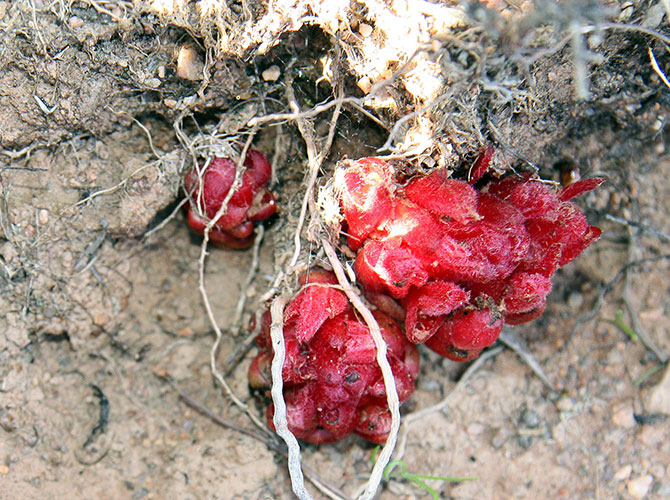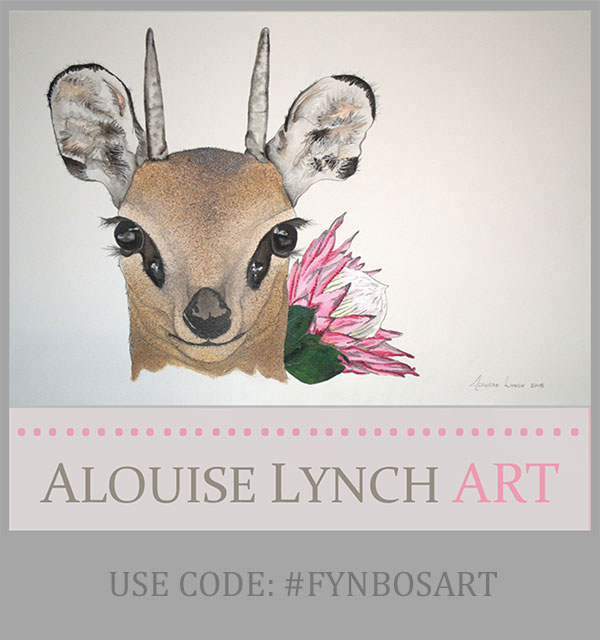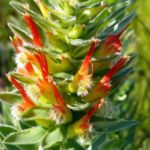
Feeding the wolves: Musings about Hyobanche sanguinea
Mention the word parasite and a number of things may spring into one’s mind: squiggling flesh-eating maggots, blood-sucking fleas and ticks, giant nematodes and many other gruesome critters too numerous to mention. It is fascinating to note that there are thousands of parasites within the plant kingdom as well and one of South Africa’s most well-known and widespread examples, Hyobanche sanguinea is pink and furry and really rather beautiful.
This species answers to a number of very different common names. The most often used is the ‘Cat’s Claw’ so named because when in full flower the white stigma curves out of the corolla tube making it resemble its namesake. But I’m yet to meet any pink cats running around South Africa.
The Pink Panther perhaps? Moving on from inept French detectives, an even more bizarre common name given to Hyobanche sanguinea is ‘Wolwekos’, which when translated from Afrikaans means ‘Wolf food’. However, if Aristotle is to be believed, the closest indigenous lupine creatures to the Cape hail from Egypt. More recent research indicates their presence in the Ethiopian highlands, Mali and Senegal. So the wolves would have a very long commute to find their dinner.
Hyobanche sanguinea is also known as the Ink Flower. This name has its roots more deeply ingrained in South Africa’s history than the other common names of this species. During early colonial times, the flowers of this species were collected, dried and crushed to form a black powder which was then diluted to be used as ink.
Hyobanche sanguinea is a type of holoparasite, thus meaning that unlike other plants it does not photosynthesise for its food. Instead, it attaches itself to the roots of other plants, in order to draw water and nutrients from its hosts.
It also doesn’t have any roots. Instead, it has a long fleshy organ known as a haustorium, used to attach itself to the host plant and transfer nutrients. This can grow up to two metres in length on its hunt to find an appropriate host plant.
The rhizome of the plant is covered in modified bracts that can form secondary haustoria. When a host root touches the bract, it will grow a secondary haustorium, thus meaning that one plant can be attached to multiple hosts of different species at once. Germination of the tiny seeds of this species is stimulated by chemicals secreted by the roots of the host species.
This species has a fairly widespread distribution, with occurrence across South Africa from the Cape northwards to the Gariep River and eastwards as far as Lesotho and Swaziland. It generally grows on sandy, nutrient-poor soils and flowers from August to November.
Most species in the Hyobanche genus were described in the early 1900s, but with little taxonomic information documented. It is only been in recent years that a deeper understanding of these fascinating plants has been attained. It is also difficult to determine exactly which host plants are parasitised by this species because of the extensive rhizome system, but it is thought that genera include Aspalathus, Berkheya, Cliffortia, Hermannia, Metalasia and Protea.
So herewith you have a little of the inside story of these pink furry members of South Africa’s plant community. Now just watch out for those wolves…….
Find me on Instagram
Plant Information
Connect on Social
Connect on Facebook, Twitter and Instagram
Taking Action
There are many environmental organisations based in Cape Town and beyond that require the services of volunteers to undertake their work. So if you have a little time to spare please get involved.






